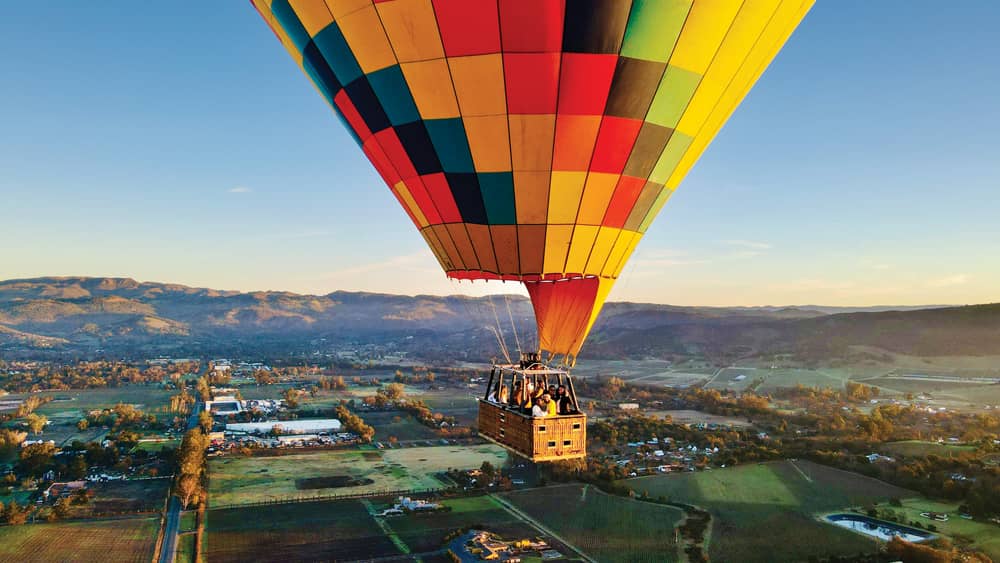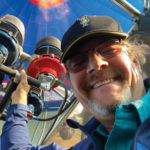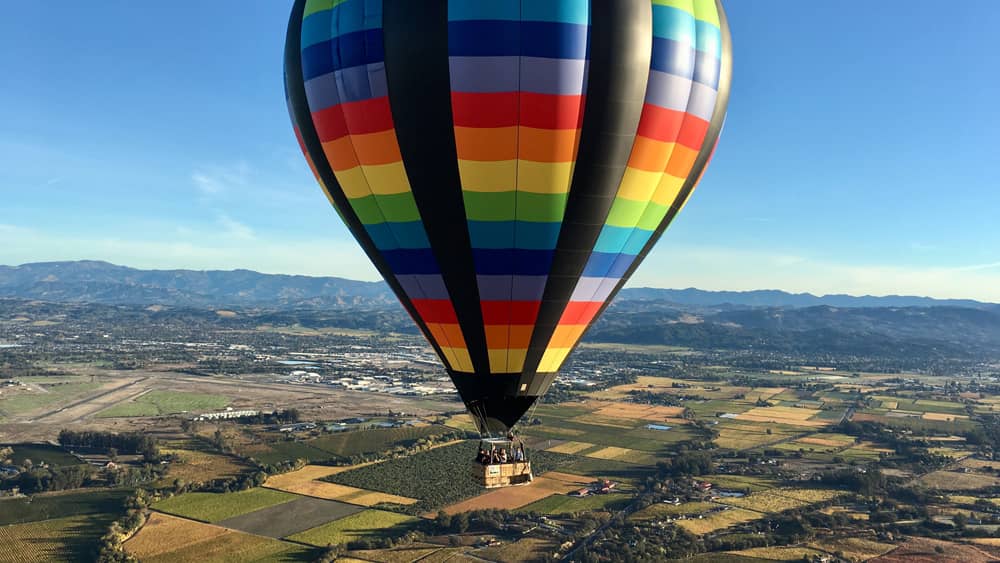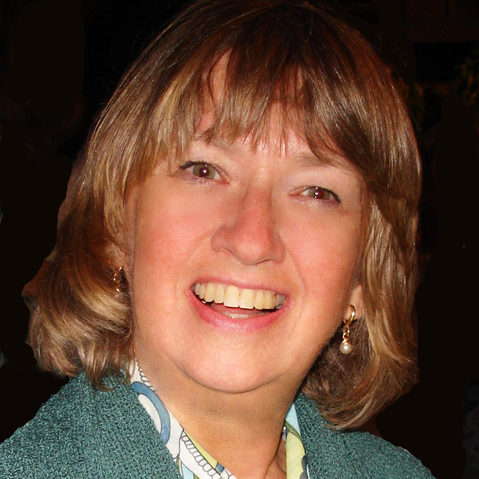
Brightly colored hot-air balloons drifting through a clear blue sky are a magical sight, and the view from aloft is equally captivating. Riding with the wind in a basket suspended from a giant balloon is exhilarating for those with an adventurous spirit, and the experience provides a rare chance to view the hills, valleys and landmarks they’ve seen at ground level from an entirely new perspective.
Riding high
Scott van der Horst of Wine Country Balloons in Sebastopol saw a hot-air balloon for the first time when he was 10, merely a decade after modern hot air balloons were first invented. It was red, white, blue and tethered to the ground to draw attention to the opening of the first indoor shopping mall in Flint, Mich. He had to wait until he was 13 for his first ride, but it was on a fog-shrouded day, so he didn’t expect to see much. As the balloon slowly rose into the air, though, it left the low-lying fog below, and he looked down to discover a fluffy white carpet with treetops poking through.

van der Horst’s father piqued his interest in balloons. The elder van der Horst bought his first balloon in 1974, when ballooning popularity was just starting to take off, and they both learned how to fly under the tutelage of Dennis Floden, who was known in balloon circles as Capt. Phogg, a moniker that is presumably a nod to Phileas Fogg, the character who circumnavigated the globe in a hot air balloon to win a bet in Jules Verne’s novel Around the World in Eighty Days. Scott applied for his student permit at 14 so he too could learn how to fly a balloon. The father-son duo traveled the country attending balloon events. “My father and I learned to fly balloons in tandem, and we took our balloon to travel to different places,” he explains, listing Iowa, West Virginia and New York as a few of the spots they visited. They even flew the balloon at the Kentucky Derby. When he was 16, he passed the FAA examinations and earned a private ballooning certification, which allowed him to take friends and family for rides—but not for money. He received his commercial rating at age 18 and flew passengers for hire in the Detroit News balloon in Rochester, Mich. During the early evening hours after attending high school during the day.

Family affair
Jared Kimball of Napa Valley Aloft in Yountville was so small when he went on his first balloon ride that he wasn’t tall enough to see over the basket. He peered through the little footholes passengers used to climb in and out of the basket instead and saw cars that looked like Hot Wheels toys below. “It almost looked like a board game,” he recalls. “It was so cool. Everything was so minuscule.”
His family’s enthusiasm for balloons began with his father, Jay Kimball, a glider pilot who founded the company in the 1970s, when Napa Valley, was beginning to emerge as a wine destination. He and five friends had started a club, but when they saw the growing demand for balloon rides, they quit their day jobs as carpenters and created a balloon company as equal shareholders. Other opportunities beckoned, however, and he moved to Del Mar in San Diego County and started another balloon business there. He had sold his shares and was out the picture in Napa Valley but returned periodically to catch up with his buddies and buy equipment. During a visit in 2011, he crossed paths with Carol Ann and Nielsen Rogers, who owned Napa Valley Aloft. They wanted to sell the company and knew Kimball was still in the balloon business, so they asked if he’d like to buy it. “Collectively, as a family, we decided to go forward with the purchase,” says Jared Kimball.

The goal was to create a viable family business, so they collaborated to identify each individual member’s strong points and find ways to capitalize on them. Jay, who is now 73 and has logged over 10,000 flying hours, is a consultant, sharing the knowledge he’s acquired over the years. “He has a strong passion for hot air ballooning,” says Jared, but being a pilot requires flying every day and is a big commitment. “It’s more appealing for him to come out and fly on his own schedule,” he explains. His brother, Jayson, and sister, Gretchen, earned their commercial pilots’ licenses in 1995 when they were 18 and 20 respectively. “My brother was very passionate about it and made it his career,” says Kimball, and in addition to being a pilot, he’s also responsible for the equipment and crew and goes to balloon events throughout the country. “My sister has a strong art background, and that’s her passion,” he says, but she flies when she’s needed and finds that the view gives her a perspective that complements her painting. She gives suggestions for improvement as well, and Kimball points out that Napa Valley Aloft is primarily a business, and they are always seeking ways to be better.
His expertise is on the ground, handling business development and overseeing areas such as compliance, bookkeeping, reservations and customer service. He learned about flying, had in-flight training and soloed, and “It was a cool thing. I kind of owed it to myself to give it a go,” he says, but he decided to pursue other opportunities. Among them, he owned a tour company and worked in the wine industry, which allowed him to acquire skills that he now applies at Napa Valley Aloft. “It’s aviation, but it’s a hospitality business,” he observes, and he approaches it with a customer-first mentality. His mother, Linda Kimball, who is divorced from his father, rounds out the family team as the mother of the business as well as the family. She has a background in managing wine tasting rooms. “She’s always mediating,” he says.
Reconnecting
Jeff Spear, the owner of Sonoma Ballooning Adventures, has an aunt who had a big balloon company in Washington State when he was young, and he took his first ride when he was a child, maybe five. “I loved it,” he says. He continued ballooning and has flown in locales around the country, including Sequim (pronounced Skwim) on Washington’s Olympic Peninsula. “It’s a great place to fly, awesome,” he says. He explains that one of ballooning’s great pleasures is the variety it offers. “Every day is different,” he says, with people, weather patterns and landing sites always changing. For Spear, though, ballooning was a recreational activity, and when it was time to embark on a career, he became an airline pilot and served in the U.S. Coast Guard. Then five years ago, he and his wife settled in Sonoma, which he calls home, and his aunt sparked a renewed interest in hot air ballooning when she took him to the Sonoma County Hot Air Balloon Classic and offered to teach him how to fly a balloon if he liked it. He was hooked. He earned his commercial license and started flying for Sonoma Ballooning, which has its home base in Sonoma Skypark, just three miles from the city’s historic plaza. In spring 2020, however, ballooning came to a standstill, yet another casualty of the COVID-19 pandemic. “We were shut down,” says Spear, but the months of inactivity gave him an opportunity. The owner decided to sell the company, and he purchased it in October 2020.

Running with the wind
Hot air balloons are relatively simple aircraft, consisting of a balloon—known as an envelope—a basket and a burner system. The first hot air balloon on record was a French invention in 1783, and it was made of cloth and lined with paper. It was inflated with the heat from straw that was burned with wool and dried horse manure to keep the flame low so it wouldn’t ignite the balloon. The passengers were a sheep, a duck and a rooster, and the flight was experimental and lasted only a few minutes. Since the birth of modern hot air balloons in 1960, propane burners are used to excite the molecules of air inside the balloon bag or ‘envelope.’ The less-dense hot air rises, being lighter than the surrounding cooler, heavier air mass which displaces the balloon, causing it to ascend. This compares to the way a beach ball is pushed up towards the surface by the heavier water below. The pilot simply lets some air out or decreases the heat, reducing the temperature of the air inside the balloon to make it descend. “We have a remarkable amount of control over the up and down movement,” says van der Horst, but only the wind currents can determine direction and speed. “As you rise and fall in different layers, the wind carries the balloon. A pilot can contribute to the outcome, but you can’t directly control it,” he explains. Piloting a balloon is a combination of determination, opportunity, skill and serendipity.
The nature of hot-air ballooning makes the exact route and landing site uncertain, but finding the right place to take off is important. In Wine Country, hot air balloons go up early in the morning, because that’s when the winds are cool and calmest, and van der Horst explains that his company puts up a helium-filled balloon and watches it to observe the wind direction to determine what may be the best launching site. He describes the air movement along the Russian River Valley is much like a river, with wind currents instead of water currents. The wind currents carry the balloon. “We take off and drift along until we find an appropriate place to land. Our landings are always guaranteed, but we don’t know exactly where,” he says. A chase crew in vehicles follows a balloon to meet it where it lands, pack everything up and take the passengers to a café for a celebratory champagne toast and breakfast with the pilot.

The balloons themselves are made from nylon or polyester. Polyester balloons last 700 hours, while nylon balloons last for 300 to 400 hours, and then they need to have the top third replaced because the heat concentrates there, making the fabric deteriorate more quickly than the lower two-thirds. They’re made in half a dozen factories around the world, and clients can create their own designs. Sometimes they’re to advertise a business, and Van der Horst designed one to look like a marshmallow-studded chocolate confection to promote his wife Christine’s company Off Your Rocker, which makes gourmet rocky road candy in different flavors. They took it to Albuquerque, which hosts the country’s largest balloon festival, and gave away 4,000 samples of the sweets to balloon enthusiasts.
Over and above
For most people, a hot air balloon ride is a once-in-a-lifetime experience, and operators strive to make it memorable. A champagne toast following a flight is traditional, and sometimes breakfast follows. Napa Valley Aloft’s home base is V Marketplace in Yountville, and its neighbor Ottimo, Michael Chiarello’s restaurant, is the destination for a post-flight meal and conversation. The company also has partnerships with Vintage Estate and Villagio. “We work with both hotels. … A rising tide lifts all ships,” says Kimball, explaining that they enhance each other’s businesses. He adds that people who visit Yountville want a small-town intimate feel, and his company aims to provide it. “The balloon ride is going to take care of itself,” he says. The activities leading up to and following a flight can add a personal touch and are a way to differentiate a company. “My family didn’t own vineyards or wineries,” he says, and offering visitors a unique experience is something they could contribute to Napa Valley.
For those who want to go beyond a balloon ride, Sonoma Ballooning Adventures offers additional activities in partnership with other local businesses. The aim is to create an overall experience, especially if guests are from other areas or countries. They might visit Charlie’s Acres, a Sonoma animal sanctuary that rescues farm animals from bad situations, and then go wine tasting at two vegan wineries with La Belle Vie Tour. Another option is a special wine-tasting with Meadowcroft Wines at Cornerstone Sonoma, where guests can blend their own bottle of wine. “It’s all about community and introducing people to unique experiences they can’t get at home,” says Lisa Strom, marketing director for Sonoma Ballooning Adventures.

Riding aloft in a hot air balloon is an incomparable experience. A flight starts with a gentle liftoff, and then you float through the air, drifting in a tranquil environment detached from the earth. The landscape comes into soft focus, and there’s no sensation of height, so you feel like you can reach down and touch mountains. And as the wonders unfold, a ride becomes Wine Country’s version of a magical mystery tour, creating memories that will last forever.
The Inside Track
Lisa Strom of Sonoma Ballooning Adventures shares some tips and tidbits for making the most of a balloon ride. “We love what we do. We want to share the joy and magic of hot air ballooning with guests who are coming to town,” she says. People of all ages and backgrounds enjoy hot air balloon rides. Here’s what to expect on a hot air adventure.
Pre-flight, passengers enjoy coffee or tea and a snack while they watch the balloon being inflated. It’s a chance to take some photos before boarding.
The flight is 45 minutes to an hour, and the panoramic views also provide great photo ops. The pilot will point out places of interest and share some history, giving passengers a chance to learn more about the area’s history, topography and places on the ground they might visit
It’s cool in the morning, but passengers can feel the heat from the balloon, so wear the appropriate attire. Strom suggests dressing as if you’re going on a hike.
Wear sturdy shoes. Pilots look for clear open spaces to land, but sometimes people have to hike through grassy terrain to reach the shuttle van.
Be prepared to climb in and out of the basket and stand throughout the flight.
Pilots are knowledgeable about the area and can provide suggestions for places to eat and wineries to visit.
Hot Air Balloon History
1783: In September, the first hot air balloon lifted off with a sheep, a duck and a rooster on board, staying aloft for 15 minutes.
Two months later, the first manned flight, in a balloon designed by French brothers Joseph and Etienne Montgolfier, launched from the center of Paris and stayed in the air for 20 minutes.
1785: French balloonist Jean Pierre Blanchard and copilot John Jefferies, an American, were the first to fly across the English Channel, in the first step to long-distance ballooning.
1793: Blanchard was the first pilot to fly a hot air balloon in North America. George Washington watched the launch.
The 1950s: In the latter part of the decade, Ed Yost created a light burner that used bottled propane, allowing balloonists to reheat the air, thus making longer flights possible. Previously, balloons either had onboard fires, or the air was heated while the balloon was still on the ground.
1960: Yost took the first modern hot air balloon flight in Bruning, Neb. It lasted for one hour and 35 minutes.
1999: Bertrand Piccard of Switzerland and Brian Jones of Britain were the first to circumnavigate the globe in a hot air balloon. They started in the Swiss Alps and traveled for 19 days, 21 hours and 55 minutes, touching down in Mauritania in North Africa.
2002: American Steve Fossett was the first pilot to complete a solo flight around the world. He used a computer-assisted burning system and ascended to a high altitude to take advantage of the jet stream. It was his seventh attempt and took just under 15 days.
Source: eballoon.org




